By Damir Šegon, Denis Vida and Paul Roggemans
Abstract: A new meteor shower on a Jupiter Family Comet type orbit (TJ = 2.91) has been detected during 2025 September 12 – 18 by the Global Meteor Network. 81 meteors belonging to the new shower were observed between 170° < λʘ < 176° from a radiant at R.A. = 308.8° and Decl.= +9.7° in the constellation of Delphinus, with a geocentric velocity of 12.5 km/s. The new meteor shower has been listed in the IAU MDC Working List of Meteor Showers under the temporary name-designation: M2025-S1.
1 Introduction
The GMN radiant maps for September 14 – 17, 2025 showed a clear concentration of related radiants in the constellation of Delphinus, south of the chi Cygnid radiant (CCY#757). 81 meteors of this meteor shower were observed by the Global Meteor Network low-light video cameras during the period 2025 September 12 – 18 with most events on September 15 – 16 (Figure 1). The shower was independently observed by cameras in 22 countries (Australia, Belgium, Bulgaria, Brazil, Canada, Croatia, Czechia, Denmark, Germany, France, Hungary, Italy, Luxembourg, Netherlands, New Zealand, Slovakia, Slovenia, South Africa, South Korea, Spain, United Kingdom and United States).
The shower had a median geocentric radiant with coordinates R.A. = 308.8°, Decl. = +9.7°, within a circle with a standard deviation of ±2.6° (equinox J2000.0) see Figure 2. The radiant drift in R.A. is +0.47° on the sky per degree of solar longitude and +0.72° in Dec., both referenced to λʘ = 172.9° (Figures 3 and 4). The median Sun-centered ecliptic coordinates were λ – λʘ = 141.2°, β = +27.4° (Figure 5). The geocentric velocity was 12.5 ± 0.1 km/s.
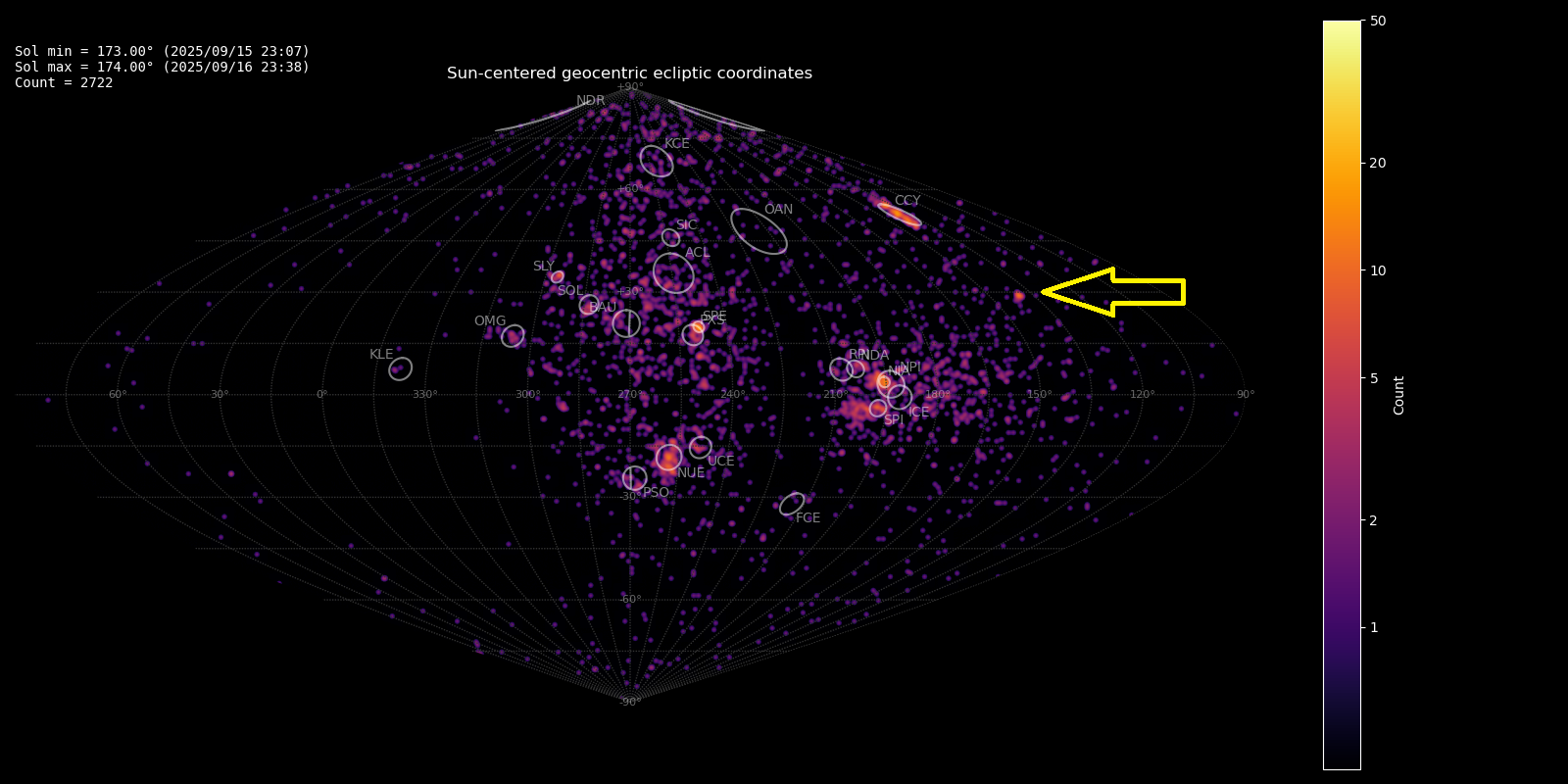
Figure 1 – Heat map with 2722 radiants obtained by the Global Meteor network on September 15 – 16, 2025. A distinct concentration is visible in Sun-centered geocentric ecliptic coordinates which was identified as a new meteor shower with the temporary identification M2025-S1. Activity from this new source was detected during several days.
2 First detection
The GMN shower association criterion assumes that meteors within 1° in solar longitude, within 3° in radiant, and within 10% in geocentric velocity of a shower reference location are members of that shower. Further details about the shower association are explained in Moorhead et al. (2020). This is a rather strict criterion since meteor showers often have a larger dispersion in radiant position, velocity and activity period. Using these meteor shower selection criteria, 81 orbits have been associated with the new shower in the GMN meteor orbit database. The mean orbit has been listed in Table 1. Figures 6 and 7 clearly show that the new activity source appeared on top of the sporadic background noise.
This possible new meteor shower was reported to the IAU MDC Working List of Meteor Showers and added under the temporary identification 2025-S1.
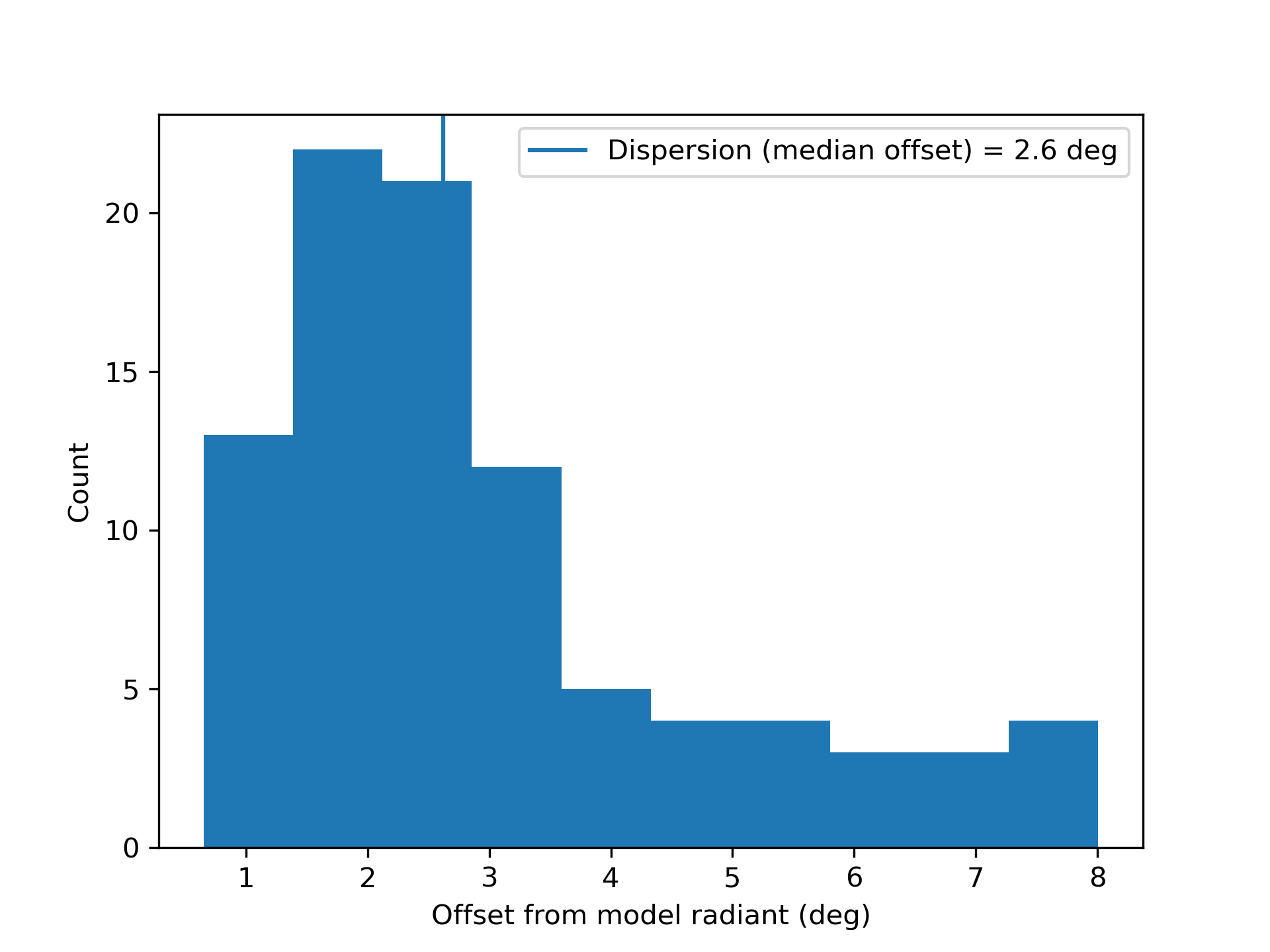
Figure 2 – Dispersion on the radiant position.
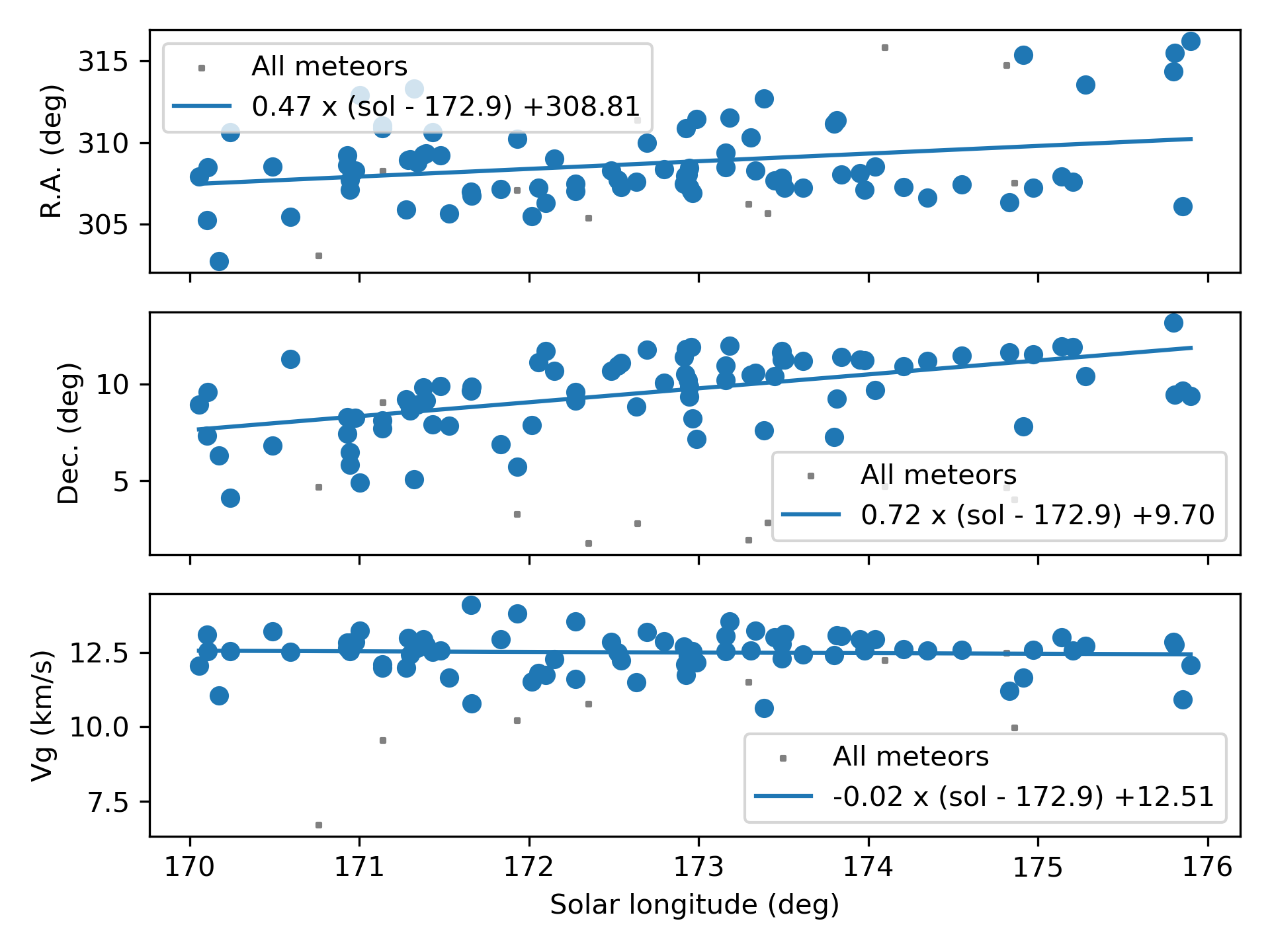
Figure 3 – The radiant drift.
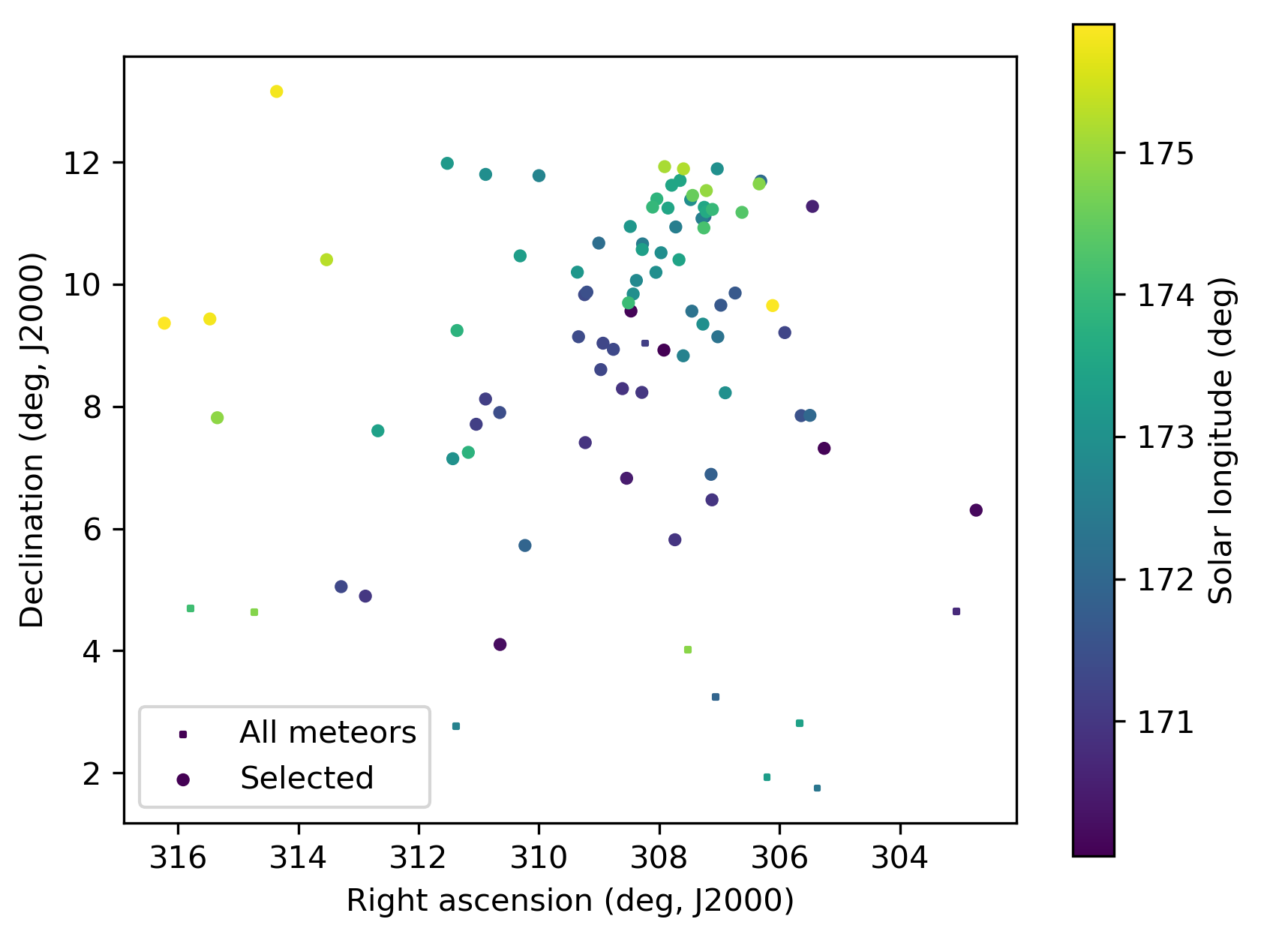
Figure 4 – The radiant distribution during the solar-longitude interval 170° – 176° in equatorial coordinates.
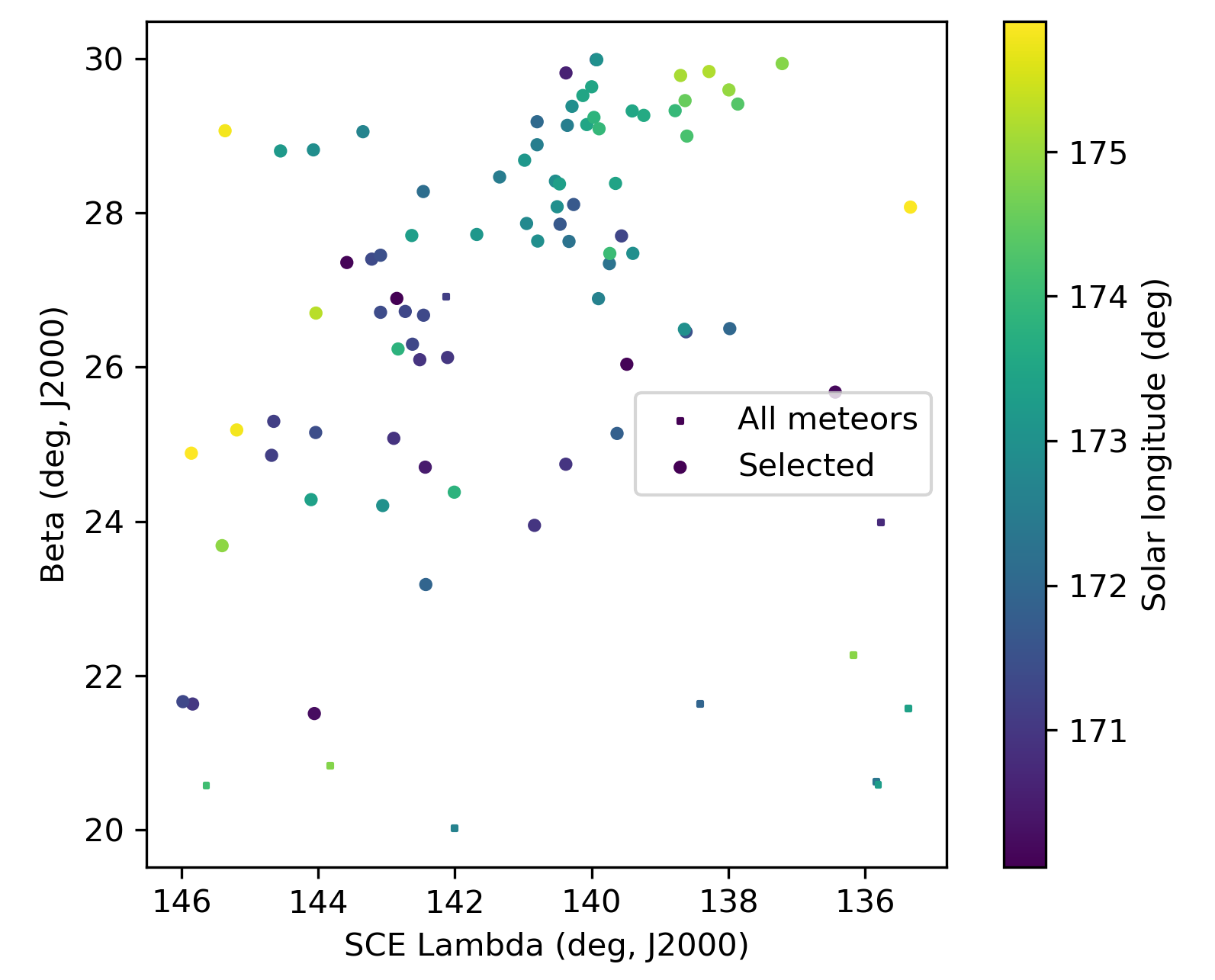
Figure 5 – The radiant distribution during the solar-longitude interval 170° – 176° in Sun centered geocentric ecliptic coordinates.
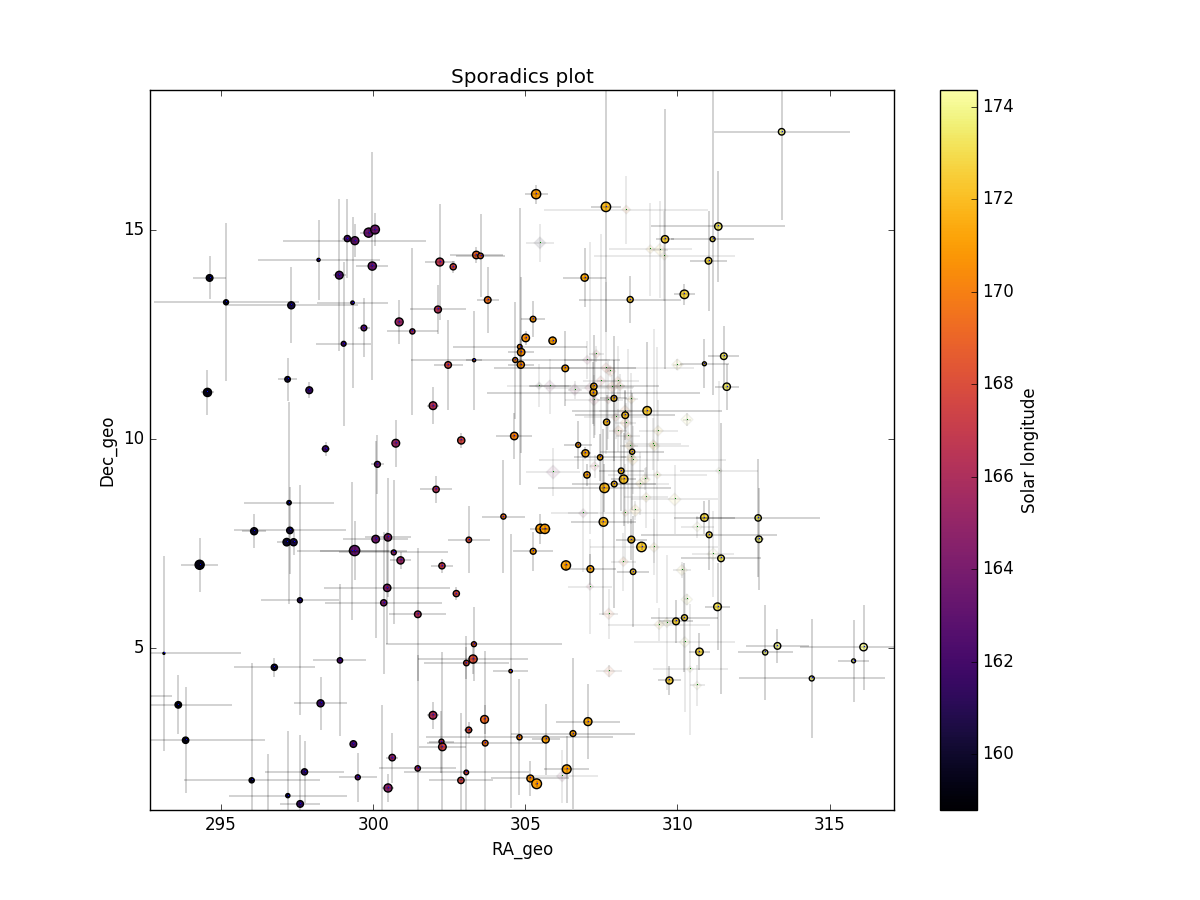
Figure 6 – All non shower meteor radiants in geocentric equatorial coordinates during the shower activity. The pale diamonds represent the new shower radiants plots, error bars represent two sigma values in both coordinates.
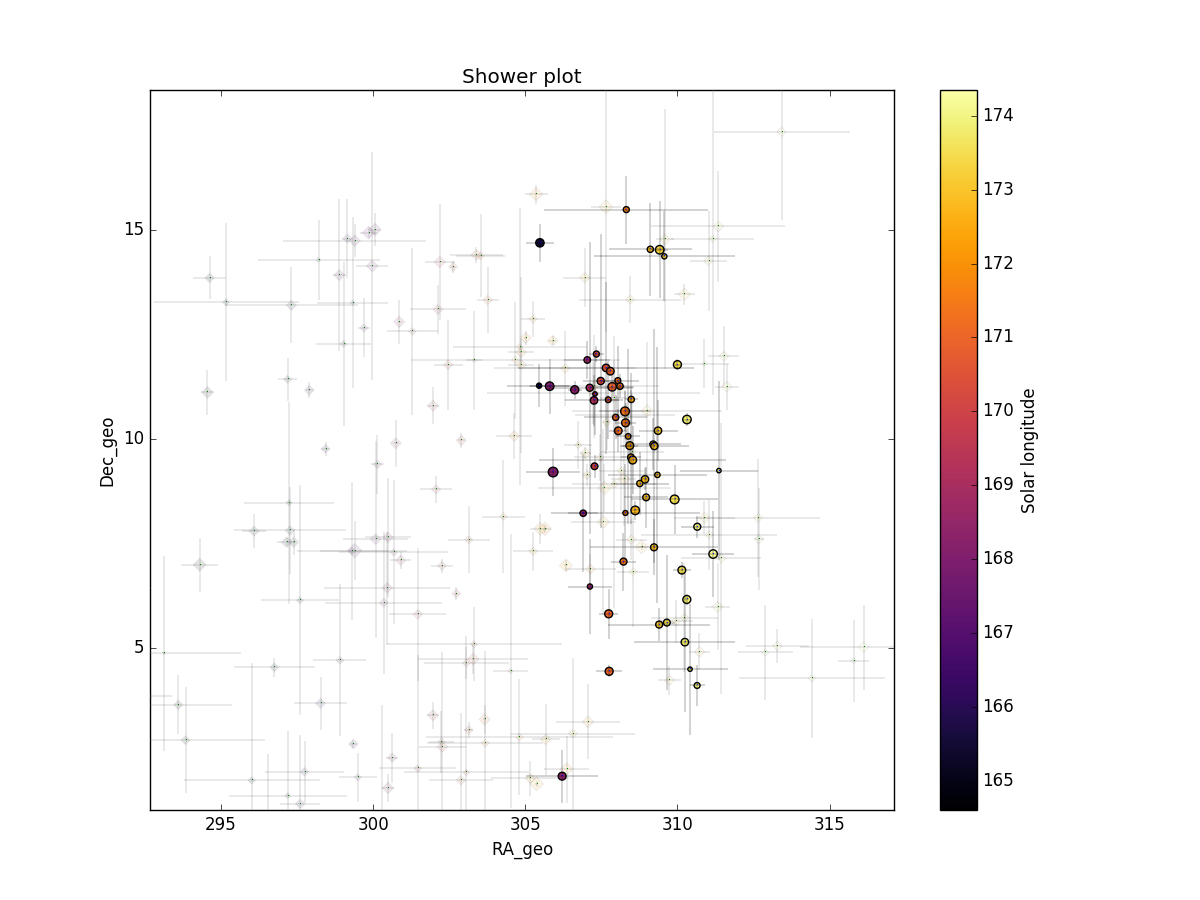
Figure 7 – The reverse of Figure 6, now the shower meteors are shown as circles and the non shower meteors as grayed out diamonds. Note that there are no other groups of meteor radiants to be seen in the vicinity of the possibly new meteor shower.
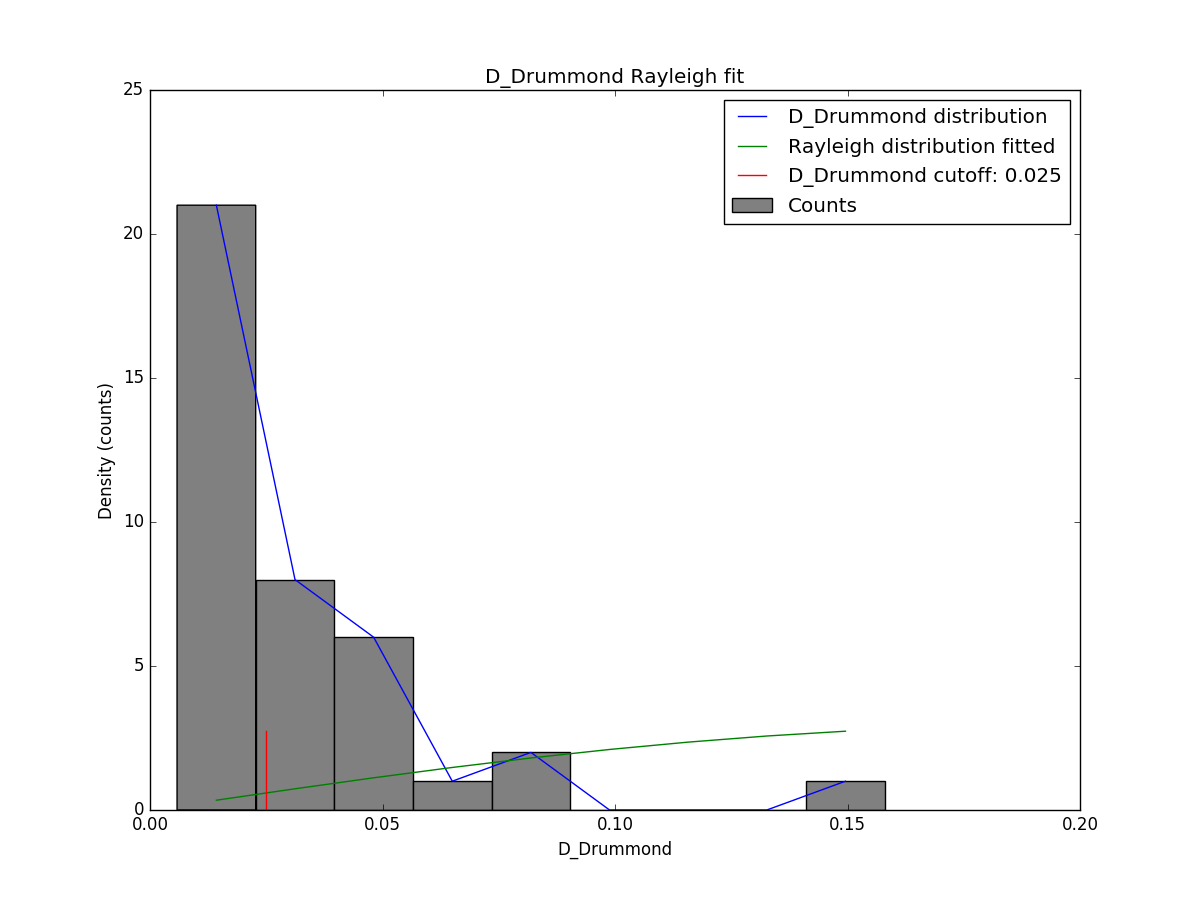
Figure 8 – Rayleigh distribution fit and Drummond DD criterion cutoff.
3 Another search method
Another method has been applied to check this new meteor shower discovery. The starting point here can be any visually spotted concentration of radiant points or any other indication for the occurrence of similar orbits. The method has been described before (Roggemans et al., 2019). The main difference with the method applied in Section 2 is that three different discrimination criteria are combined in order to have only those orbits which fit different criteria. The D-criteria that we use are these of Southworth and Hawkins (1963), Drummond (1981) and Jopek (1993) combined. Instead of using a cutoff value for the threshold of the D-criteria these values are considered in different classes with different thresholds of similarity. Depending on the dispersion and the type of orbits, the most appropriate threshold of similarity is selected to locate the best fitting mean orbit as the result of an iterative procedure.
The Rayleigh distribution fit indicates that a very small cut-off value is required with DD > 0.025. The use of D-criteria requires caution for this type of low inclination short period orbits. Because of the very small cutoff of the threshold values of the D-criteria, only two classes were plotted. This method resulted in a mean orbit with 52 related orbits that fit within the similarity threshold with DSH < 0.05, DD < 0.02 and DJ < 0.05, recorded 2025 September 12 – 18. The plot of the radiant positions in equatorial coordinates, color coded for different D-criteria thresholds, shows a clear concentration in Right Ascension from about 305° to 310° and 7° to 13° in declination (Figure 9), see also Figure 4. A slightly more tolerant threshold of the D-criteria with DSH < 0.075, DD < 0.03 and DJ < 0.075 results in 78 orbits that fit these threshold values, but with a risk of including some sporadics. Both solutions are mentioned in Table 1.
Looking at the Sun-centered geocentric ecliptic coordinates the radiant drift caused by of the Earth moving on its orbit around the Sun should be compensated resulting in a more compact radiant. However, Figure 10 shows a more stretched radiant area which is due to a remarkable strong radiant drift in Sun centered ecliptic coordinates with Δ(λ – λʘ) = –1.1° and Δβ = +0.7°. This unusual dispersion in Sun-centered ecliptic coordinates is also found by the GMN meteor shower identification method, although less pronounced with Δ(λ – λʘ) = –0.3° and Δβ = +0.6°. This means that orientation of the orbits rapidly change during the transit of the Earth through the dust stream.
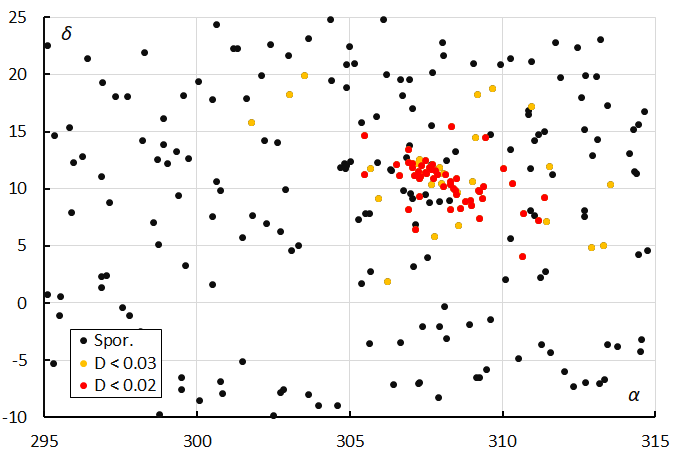
Figure 9 – The radiant distribution during the solar-longitude interval 170° – 176° in equatorial coordinates, color coded for two threshold values of the DD orbit similarity criterion.
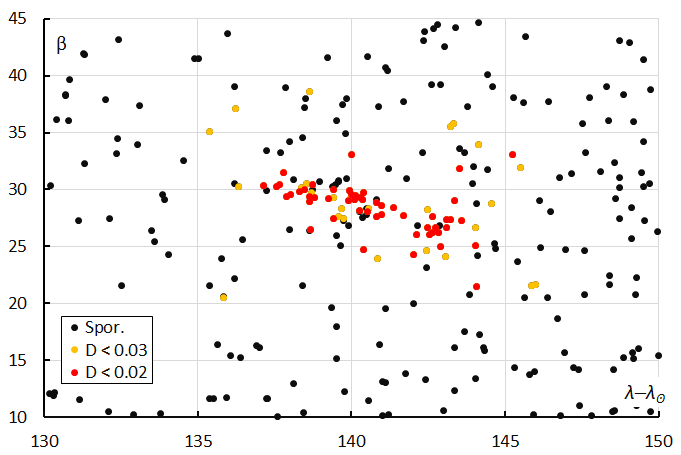
Figure 10 – The radiant distribution during the solar-longitude interval 170° – 176° in Sun-centered geocentric ecliptic coordinates, color coded for two threshold values of the DD orbit similarity criterion.
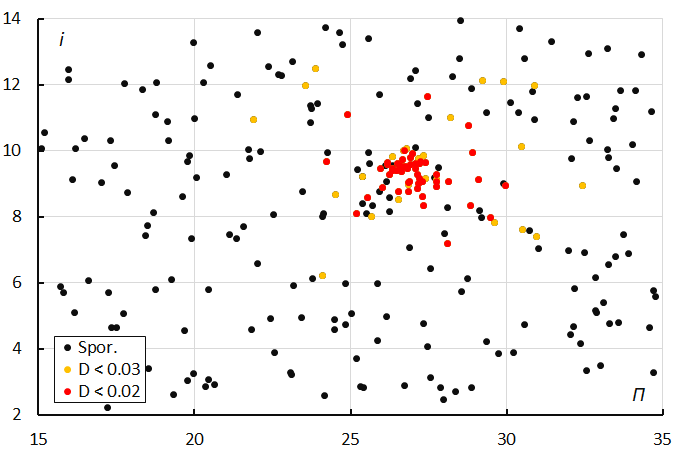
Figure 11 – The diagram of the inclination i against the longitude of perihelion Π color coded for two classes of D criterion threshold.
The diagram with the inclination against the longitude of perihelion Π (Figure 11) shows a very clear concentration of orbits. Such a dense concentration removes any doubts about the presence of strongly related orbits.
4 Comparing both methods
The first method mainly looks at the radiant positions for the classification. When we apply the D criteria, only 53 of the 81 selected meteors fulfill the threshold values of DSH < 0.075, DD < 0.03 and DJ < 0.075 for the mean orbit obtained by the GMN method. 25 of these 81 orbits were not identified by the second method, 56 were identified by both methods. The second method associated 22 orbits that were ignored by the first method. The reason for the discrepancies between the two methods is due to the very low geocentric velocity and unusual radiant drift in Sun-centered ecliptic coordinates.
Despite the difference between the samples based on the two different methods, the final mean orbits are in very good agreement except for the radiant drift in R.A. The second method sampled more orbits on a slightly higher inclination than the GMN radiant based method as the orbits are tested with D-criteria regardless their radiant position.
Table 1 – Comparing the new meteor shower, derived by two different methods, M2025-S1 the orbital parameters as initially derived, the parameters under DD < 0.03 and DD < 0.02 were derived from the method described in Section 3.
| M2025-S1 | DD < 0.03 | DD < 0.02 | |
| λʘ (°) | 172.9 | 172.8 | 172.95 |
| λʘb (°) | 170.0 | 170.1 | 170.1 |
| λʘe (°) | 176.0 | 175.5 | 175.5 |
| αg (°) | 308.8 | 307.7 | 308.0 |
| δg (°) | +9.7 | +11.5 | +10.9 |
| Δαg (°) | +0.47 | –0.25 | –0.28 |
| Δδg (°) | +0.72 | +0.93 | +0.65 |
| vg (km/s) | 12.5 | 12.5 | 12.6 |
| λg (°) | 314.08 | 313.5 | 313.6 |
| λg – λʘ (°) | 141.18 | 140.7 | 140.4 |
| βg (°) | +27.37 | +29.4 | +28.9 |
| a (A.U.) | 2.85 | 2.92 | 2.93 |
| q (A.U.) | 0.933 | 0.934 | 0.935 |
| e | 0.672 | 0.680 | 0.681 |
| i (°) | 8.9 | 9.1 | 9.3 |
| ω (°) | 214.7 | 214.3 | 214.0 |
| Ω (°) | 172.7 | 172.65 | 173.0 |
| Π (°) | 27.4 | 27.0 | 27.0 |
| Tj | 2.91 | 2.87 | 2.86 |
| N | 81 | 78 | 52 |
5 Orbit and parent body
The final mean orbits obtained by the two methods are in good agreement (Figure 11, Table 1). Figure 13 shows the orbits in the inner solar system. The dust of M2025-S1 crosses the Earth orbit at its descending node, hitting the Earth almost from the rear, hence the very slow entrance velocity. The low inclination and aphelion close to the orbit of Jupiter means that dust trails will be much affected by this giant planet’s gravitational perturbations. This could explain why this meteor shower appears to be almost absent in past observational data.
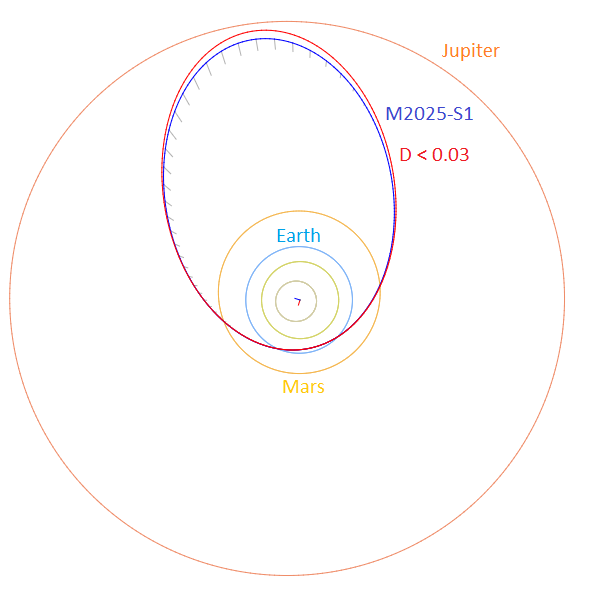
Figure 12 – Comparing the mean orbit based on the shower identification according to the two methods, blue is for M2025-S1 and red for the alternative shower search method with DD < 0.03 in Table 1. (Plotted with the Orbit visualization app provided by Pető Zsolt).
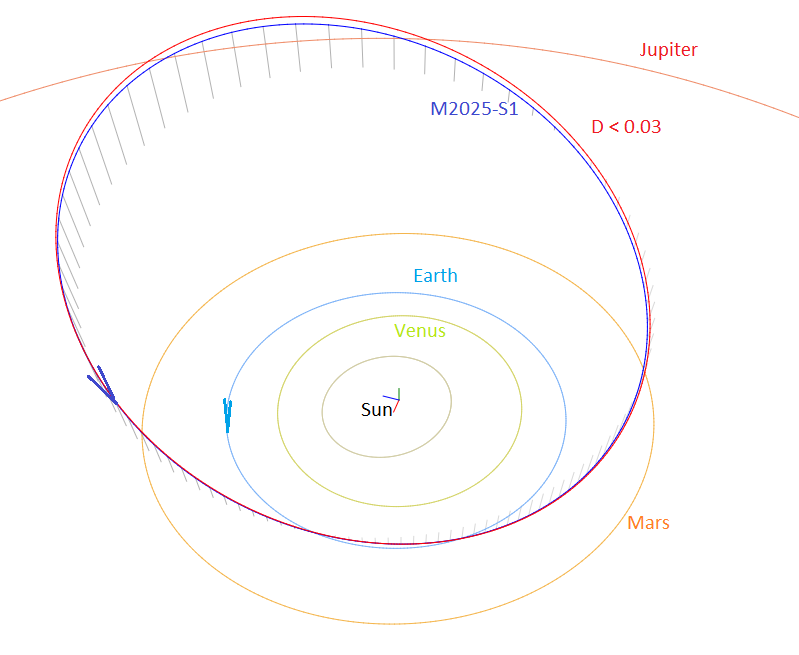
Figure 13 – Comparing the mean orbit based on the shower identification according to two methods, blue is for M2025-S1 and red for the other shower search method with DD < 0.03 in Table 1, close-up at the inner Solar System. (Plotted with the Orbit visualization app provided by Pető Zsolt).
The Tisserand’s parameter Tj identifies the orbit as of a Jupiter Family Comet type orbit. A parent-body search top 10 includes candidates with a threshold for the Drummond DD criterion value lower than 0.06 (Table 2). 2022 QF41 has a very similar orbit and could be the parent body. It would be up to meteoroid stream modelers to reconstruct the dynamic orbit evolution to see if there could be any connection between this object and this new meteor shower.
Table 2 – Top ten matches of a search for possible parent bodies with DD < 0.06.
| Name | DD |
| 2022 QF41 | 0.031 |
| 2020 MZ3 | 0.041 |
| 2021 RL6 | 0.041 |
| 1996 XX14 | 0.046 |
| 2010 RB12 | 0.051 |
| 2022 XS | 0.053 |
| 2002 RC117 | 0.055 |
| (419922) 2011 BJ24 | 0.057 |
| 2007 VG3 | 0.057 |
| 2005 RJ | 0.059 |
6 Activity in past years
A search in older GMN orbit data resulted in seven possible orbits with DD < 0.02 in 2022, eleven in 2023 and only two orbits in 2024. SonotaCo Net has only one orbit with DD < 0.02 in 2019. EDMOND had only one orbit with DD < 0.02 in 2015. No other meteor orbit datasets were checked. The activity in the past years indicates that M2025-S1 is an annual shower but remained far below the threshold to be discovered in previous years.
7 Conclusion
The discovery of a new meteor shower with a radiant in the constellation of Delphinus based on Eighty-one meteors during 2025 September 12 – 18 has been confirmed by using two independent meteor shower search methods. The resulting mean orbits for both search methods are in good agreement. All meteors appeared during the solar-longitude interval 170° – 176°, with most events around 15 – 16 September (around λʘ = 172.9°). Orbits of this meteor shower were detected in previous years, but the activity level remained well below the detection threshold.
Acknowledgment
This report is based on the data of the Global Meteor Network (Vida et al., 2020a; 2020b; 2021) which is released under the CC BY 4.0 license. We thank all 825 participants in the Global Meteor Network project for their contribution and perseverance. A list with the names of the volunteers who contribute to GMN has been published in the 2024 annual report (Roggemans et al., 2025).
References
Drummond J. D. (1981). “A test of comet and meteor shower associations”. Icarus, 45, 545–553.
Jopek T. J. (1993). “Remarks on the meteor orbital similarity D-criterion”. Icarus, 106, 603–607.
Jopek T. J., Rudawska R. and Pretka-Ziomek H. (2006). “Calculation of the mean orbit of a meteoroid stream”. Monthly Notices of the Royal Astronomical Society, 371, 1367–1372.
Moorhead A. V., Clements T. D., Vida D. (2020). “Realistic gravitational focusing of meteoroid streams”. Monthly Notices of the Royal Astronomical Society, 494, 2982–2994.
Roggemans P., Johannink C. and Campbell-Burns P. (2019a). “October Ursae Majorids (OCU#333)”. eMetN Meteor Journal, 4, 55–64.
Roggemans P., Campbell-Burns P., Kalina M., McIntyre M., Scott J. M., Šegon D., Vida D. (2025). “Global Meteor Network report 2024”. eMetN Meteor Journal, 10, 67–101.
Southworth R. B. and Hawkins G. S. (1963). “Statistics of meteor streams”. Smithsonian Contributions to Astrophysics, 7, 261–285.
Vida D., Gural P., Brown P., Campbell-Brown M., Wiegert P. (2020a). “Estimating trajectories of meteors: an observational Monte Carlo approach – I. Theory”. Monthly Notices of the Royal Astronomical Society, 491, 2688–2705.
Vida D., Gural P., Brown P., Campbell-Brown M., Wiegert P. (2020b). “Estimating trajectories of meteors: an observational Monte Carlo approach – II. Results”. Monthly Notices of the Royal Astronomical Society, 491, 3996–4011.
Vida D., Šegon D., Gural P. S., Brown P. G., McIntyre M. J. M., Dijkema T. J., Pavletić L., Kukić P., Mazur M. J., Eschman P., Roggemans P., Merlak A., Zubrović D. (2021). “The Global Meteor Network – Methodology and first results”. Monthly Notices of the Royal Astronomical Society, 506, 5046–5074.

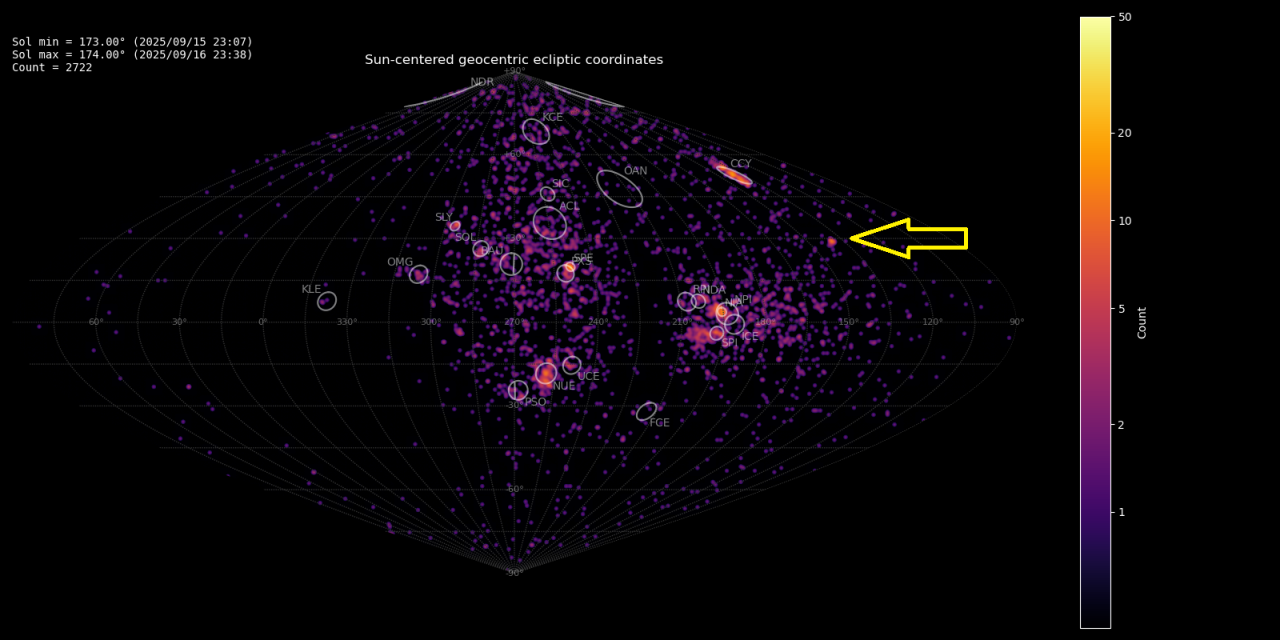
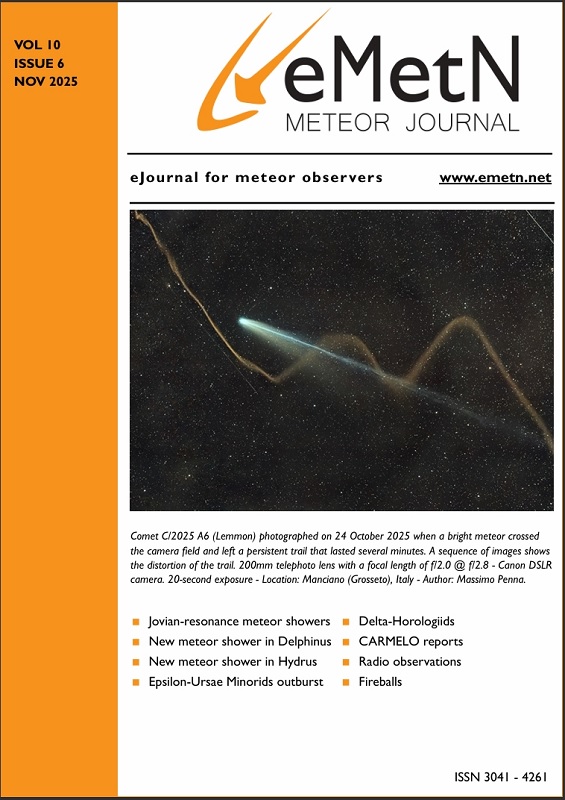


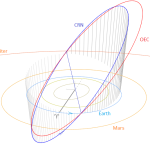
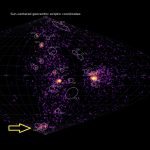
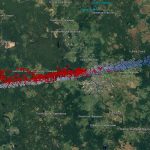
Dear Paul! Please contact me at astroseriv at gmail.com, Ivan